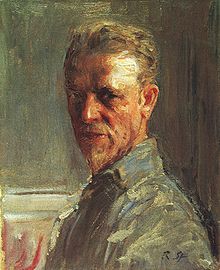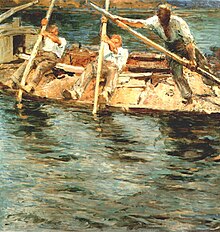Robert Sterl
Robert Hermann Sterl (born June 23, 1867 in Großdobritz ; † January 10, 1932 in Naundorf , Pirna administration ) was a German painter and graphic artist .
Life
Robert Sterl was born in 1867 as the son of the stonemason Friedrich Wilhelm Sterl. Between 1873 and 1881 he attended primary school in Dresden. He then studied from 1881 to 1888 (nominally until 1891) at the Royal Academy of Fine Arts in Dresden. He took lessons from Leon Pohle , Julius Scholtz and Wilhelm Walther, among others , and was a master student of the Belgian history painter Ferdinand Pauwels since 1886 ; since 1888 leave of absence from Pauwels' studio.
Between 1887 and 1904 Sterl worked as a landscape painter, portraitist and illustrator and ran a private painting school for women in his studio in Dresden. In 1894 he was a founding member of the "Association of Visual Artists". In 1897 he married Helene Hedelt (1873–1950); the marriage remained childless. In 1905, Sterl co-founded the artist group Die Zunft . In 1904 Sterl was appointed first as a teacher, then in 1906 as a professor at the Royal Academy of Fine Arts in Dresden, where he taught until 1931. As an early member of the German Association of Artists , he took part in several annual exhibitions until his death and was ultimately also a member of the extended board.
In 1909 he was a founding member of the Dresden Artists' Association . Also in 1909 followed the election and appointment as extraordinary member of the Berlin Secession . From 1913 to 1930 he was a member of the Dresden Gallery Commission, from 1920 also of the Dresden Gallery Advisory Board and the jury of the artists' association. In 1915, Sterl took over the master class for painting at the Dresden Art Academy, succeeding the late Gotthardt Kuehl . In the First World War, Sterl took part as a war painter. In addition, Sterl campaigned for the student council at the Dresden Art Academy. Sterl was involved in acquisitions and exhibitions for modernism and young artists.
In 1919 Robert Sterl bought a house built in 1912/13 in Naundorf in Saxon Switzerland , had a spacious studio added, and moved there with his wife Helene von Dresden.
Robert Sterl died in January 1932 after a long illness in his house in Naundorf. He was buried on the property. Otto Rometsch's tomb was built in 1937 . Sterl left his fortune to the Dresden Academy as a foundation to promote young artists. The foundation managed his house in Naundorf, where the artistic legacy of Sterl is researched and exhibited to this day. In 1957 the Robert and Helene Sterl Foundation was merged into the charitable collective foundations of the Dresden district , which have been running the Robert Sterl House in Naundorf as a museum and research facility since 1981.
Act
Along with Max Liebermann , Max Slevogt and Lovis Corinth, Robert Hermann Sterl is one of the most important representatives of German Impressionism . After studying at the Dresden Art Academy, which he left as a master class student in 1890, Sterl remained connected to his hometown until the end of his life. At the turn of the century he belonged to the circle of artists in the Goppeln artists' colony, along with befriended painters Carl Bantzer and Wilhelm Claudius . As a professor at the art academy, he had a decisive influence on the Saxon art scene for almost three decades until his death.
Robert Sterl's realistic early work is characterized by numerous landscapes created in the Dresden area and as a loose member of the Schwalm “ Willingshausen painters' colony ” in Hesse. In addition to landscapes and genre scenes, the painter and graphic artist repeatedly dealt in depth with the subject of work: He shows shepherds in the midst of romantic landscapes, harvest scenes, farming families or children who are taken to the harvest. Sketches for his portraits Stylistically around 1900, Sterl developed formally towards Impressionism, later in terms of content towards Realism in the sense of Gustave Courbet .
Robert Sterl was a sought-after portrait painter all his life.
As the son of a stonemason, Sterl is particularly connected with the Elbe Sandstone Mountains , quarries and stone crushers. With his representations he provided evidence of the history of work and technology. Sterl has dealt with this topic for over thirty years - from 1893 to the 1920s. Another subject that frequently appears at Sterl is potters in all phases of their work. His friend Carl Bantzer drew Sterl's attention to the potters' village Wittgenborn in Vogelsberg . During regular stays, in Wittgenborn (now part of Wächtersbach ) between 1894 and 1904, he collected sketches of the pottery
One of his Steinbrecher pictures from 1920, together with the Russia motif funeral procession with two priests, was removed as degenerate from the Dresden gallery Neue Meister in 1937 .
Exhibitions
- 2017: Pictures of Russia - Robert Sterl and Ernst Barlach . New Masters Gallery, Albertinum , Dresden.
- 2017: Tausendschön - Robert Sterl as an illustrator . Robert Sterl House, Naundorf.
- 2018: The Saxon painter Robert Sterl - From illustrator to impressionist . 28 March - 1 July 2018. Museum Obere Saline , Bad Kissingen.
- 2019: 'Seen, seen and experienced'. The Dresden impressionist Robert Sterl . February 3 - April 21, 2019. Museum Peter August Böckstiegel, Werther.
Honors
- Golden Medal Bene Merentibus of the Dresden Art Academy (1900)
- Gold Medal from the International Art Exhibition in Malmö, Sweden (1914)
- Honorary doctorate from the University of Leipzig (1927)
- Robert-Sterl-Strasse in the Leubnitz-Neuostra district of Dresden was named after him.
- Robert-Sterl-Strasse in Naundorf , district of Saxon Switzerland-Eastern Ore Mountains , was named after him. His former home and studio on this street is number 30. His grave is also located here.
- With the naming of a Robert-Sterl-Weg in the center of the village, Wittgenborn, a district of Wächtersbach, set a lasting monument to Robert Sterl, his long-time guest and chronicler of his traditional pottery .
Significant works
- Academy model - Africans in a half-act (1887), Robert-Sterl-Haus Naundorf
- Workers in the clay pit (1901), Dresden City Gallery
- Elbebaggerer (1905), Dresden State Art Collections, New Masters Gallery
- Portrait of the Queen Dowager Carola (1905), Dresden City Gallery
- Stone knocker (1907), Robert-Sterl-Haus Naundorf
- Ernst von Schuch conducts the orchestra (1908), Robert-Sterl-Haus Naundorf
- Arthur Nikisch conducts (1910), Museum Georg Schäfer, Schweinfurt
- Market square in Nizhny Novgorod (1910), Robert-Sterl-Haus Naundorf
- Quarry (1910), Chemnitz Art Collections
- Steinbrecher (1911), Museum of Fine Arts Leipzig
- Steinbrecher (1911), Museum Folkwang Essen
- Ernst von Schuch conducts the Rosenkavalier (1912), Staatliche Museen zu Berlin, Alte Nationalgalerie
- Ship puller on the Volga (1912), Staatliche Kunstsammlungen Dresden, Galerie Neue Meister
- Stone loader on tipping carts (1913), Robert-Sterl-Haus Naundorf
- Portrait of Dr. Otto Posse (1917), Robert-Sterl-Haus Naundorf
- Portrait of Heinrich Ernemann (1919), lost
- Kalmuck boat on the Volga (1920), Staatliche Kunstsammlungen Dresden, Galerie Neue Meister
- Self-portrait (1920), Robert-Sterl-Haus Naundorf
Robert Sterl Prize
The Dresden District Collective Foundations and the Dresden University of Fine Arts have awarded the Robert Sterl Prize annually since 1997. A jury, consisting of three professors from the Dresden University of Fine Arts and two representatives of the collective foundations of the Dresden district and the Robert-Sterl-Haus, decides on the prize of 3000 euros for a master class student at the HfBK. The award ceremony is coupled with an exhibition in the Robert-Sterl-Haus in Naundorf.
literature
- Karl Brix: "... right from the middle of life ..." on the 100th birthday of Robert Sterl. In: Sächsische Heimatblätter. Issue 5/1967, pp. 193-198.
- Horst Zimmermann: Robert Sterl and the children, paintings, graphics and drawings in the Robert Sterl House. Ed. Collective Foundations of the Dresden District, 1998.
- Robert-Sterl-Haus, Naundorf / Struppen, (= Sächsische Museen. Volume 14) Saxon State Office for Museums , Ed. Joachim Voigtmann , Berlin 2004, ISBN 3-422-03103-0 .
- The Dresden Society in portrait drawings by Robert Sterl, booklet accompanying the special exhibition. Text: Kristina Popova, Ed. Robert-Sterl-Haus, Naundorf, Collective Foundations of the Dresden District, 2007.
- Robert Sterl. Catalog raisonné of paintings and oil sketches , arr. v. Kristina Popova, ed. v. Birgit Dalbajewa and Gisbert Porstmann, Sandstein Verlag, Dresden 2011, ISBN 978-3-942422-63-5 .
- Sterl, Robert in: Hans Vollmer (Hrsg.): General Lexicon of Fine Artists of the XX. Century. Sixth volume (supplements HZ) , EA Seemann, Leipzig 1999 (study edition). ISBN 3-363-00730-2 (p. 432f)
- Horst Zimmermann: The painter Robert Sterl. Life and work in letters and personal testimonies, Sandstein Verlag, Dresden 2011, ISBN 978-3-942422-62-8 .
- Andreas Quermann, Peter Weidisch (Ed.): Tausendschön. Robert Sterl as an illustrator. Verlag Stadt Bad Kissingen, Bad Kissingen 2017, ISBN 978-3-934912-23-6 .
- Roland Halbritter: The painter Robert Sterl (1867–1932). Impressionism - work - rhythm. (Catalog for the special exhibition "The Saxon Painter Robert Sterl (1867-1932). From Illustrator to Impressionist") . With an introduction by Kristina Popova. Verlag Stadt Bad Kissingen, Bad Kissingen 2018.
Web links
- Works by Robert Sterl at Zeno.org .
- Literature by and about Robert Sterl in the catalog of the German National Library
- Robert-Sterl-Haus (former house in Naundorf, now a museum)
- Robert Sterl in Dresden (Stadtwiki Dresden)
- Works in the Dresden State Art Collections, New Masters Gallery
- Images of works in the Deutsche Fotothek, SLUB-Dresden
- Robert Sterl Archive in the Archive of the Academy of Arts, Berlin
Individual evidence
- ↑ kuenstlerbund.de: Full members of the Deutscher Künstlerbund since it was founded in 1903 / Sterl, Robert ( Memento of the original from March 4, 2016 in the Internet Archive ) Info: The archive link has been inserted automatically and has not yet been checked. Please check the original and archive link according to the instructions and then remove this notice. (accessed on April 2, 2016)
- ↑ Jürgen Schultheis, "The search for the original man - Robert Sterl - a forgotten impressionist who pursued his studies in Wittgenborn and the surrounding area" , Samml. Gesch. Wächtersbach, 42nd L., August 2003, No. 280, ISSN 0931-2641
- ↑ Angelika Baeumert, Karl Baeumert, "Robert Sterl in Wittgenborn" , Samml. Gesch. Wächtersbach, 49. L., August 2007, No. 341, ISSN 0931-2641
- ↑ J. Ackermann, "Ramholz Castle, stays of the Dresden impressionist Robert Sterl" , Samml. Gesch. Wächtersbach, 47. L., August 2006, No. 324, 3 p., ISSN 0931-2641, July 9, 2011
- ^ G. Jahn, The painter Robert Sterl and his work in Wittgenborn , Samml. Gesch. Wächtersbach, 57. L., August 2011, No. 397, 38 S., 1T. ISSN 0931-2641, July 9, 26
- ↑ Streets and squares in Leubnitz-Neuostra ( Memento of the original from October 19, 2010 in the Internet Archive ) Info: The archive link was inserted automatically and has not yet been checked. Please check the original and archive link according to the instructions and then remove this notice.
- ↑ Catalog of the Deutscher Künstlerbund Cologne 1929. May – September 1929 in the State House , M. DuMont Schauberg, Cologne 1929. (p. 32: Sterl, Robert, Dresden . Catalog No. 294 Steinbruch. , Fig. P. 104)
- ↑ The painting ( quarry. , Oil on canvas, 92 × 90 cm) was renamed in the 1930s in sunny quarry
- ↑ hfbk-dresden.de: Robert Sterl Prize
| personal data | |
|---|---|
| SURNAME | Sterl, Robert |
| ALTERNATIVE NAMES | Sterl, Robert Hermann (full name) |
| BRIEF DESCRIPTION | German painter and graphic artist |
| DATE OF BIRTH | June 23, 1867 |
| PLACE OF BIRTH | Grossdobritz |
| DATE OF DEATH | January 10, 1932 |
| Place of death | Naundorf |





